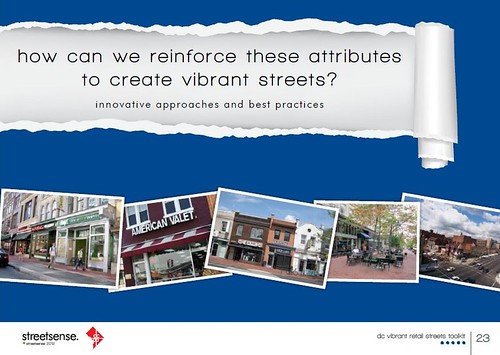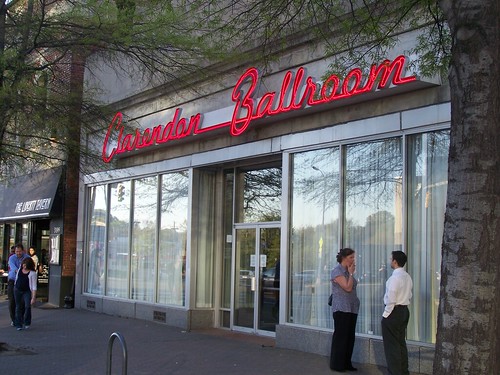The primary ingredient for retail revitalization is (after planning) conviction

page from the new DC Vibrant Retail Streets Toolkit.
Recently, the DC Office of Planning released a "DC Vibrant Retail Streets Toolkit" that they commissioned from the marketing and retail development consulting firm Streetsense, and according to an article in the Northwest Current, Streetsense believes that the report is awesome.
I haven't read it, and I'm sure it's good.
But in a larger sense, I don't think having a toolkit is the issue and I don't think it necessarily covers new ground.
-- the National Main Street Center, various trainings, conferences, materials etc.
-- the University of Wisconsin's Downtown and Business District Market Analysis Toolbox
-- the Urban Land Institute's Ten Principles for Rebuilding Neighborhood Retail
-- Business Recruitment Handbook by David Milder
-- an old publication by the Downtown DC BID which I have copied in two (Great Streets, Great Storefronts) Flickr photo sets
-- the report, Challenges of the Future: Rebirth of Small Independent Retail
-- and scads of others;
not to mention DC Office of Planning's massive "Retail Action Strategy" effort, which is a citywide plan with a number of subplans for specific commercial districts.
After a plan--with a focus on implementation--I think the most important factor is conviction.
Conviction | Vision |
Commitment to Quality & Excellence
Without conviction, and by that, I mean a total commitment to quality in all elements, you're f*ed. And I think the perfect example of this problem is Washington, DC, where for the most part, neighborhood commercial district revitalization sputters.
I meant to write about this last week, because I happened to go to meetings on consecutive days in different parts of Arlington's Wilson Boulevard corridor, and I was just bowled over by the vitality on the corridor between Courthouse and Clarendon Metro Stations, not that I got many photos, as I was biking to my meeting.

It's not like I don't know about what Arlington has done planning-wise over the years, but I thought back to a presentation I gave to the Clarendon Alliance maybe in 2006, about some of the issues they had there, including scale and urban design problems, and there is no question about Arlington's conviction--their commitment to great planning followed by great execution and implementation supplemented by incremental improvement through analysis and learning from their mistakes.
At the same time that I had seen people shopping, dining, walking, biking, rollerblading, running, using transit on Wilson Boulevard, the City Paper Housing Complex blog ran this piece, "Yes! Organic Market Interested in Bruce Monroe Site…Eventually," about a proposal for a development on the old Bruce Monroe School site on Georgia Avenue, which is a key and important site in its node, bracketed by H bus service going East-West, which connects to the north-south bus services on Georgia Avenue.
To me, it sounds like the city would be happy with anything, and isn't shaping what could happen there, but rather open to anything. Sorta like how Walmart's plans to build six stores in DC is reshaping the retail environment for the city, regardless of a Retail Toolkit.
The planning office does it's thing, but it only can try to convince the elected officials, and the Deputy Mayor's office of Planning and Economic Development, which has its own projects and staff of project managers running various initiatives across the city, from Walter Reed redevelopment to Skyland redevelopment to Reservation 13 ridiculousness etc., to do good work.
Mostly, there just isn't the will in DC--maybe it is the lack of knowledge of other places, and best practices from elsewhere--to do good work, people are satisfied with any sort of activity at all, because they believe that any activity is better than no activity. And they don't know the difference between quality and s***.

So it's not like DC can't do good work, it's just that I think it's more a function of the luck of the draw of quality developers, rather than anything that the city's elected officials or Deputy Mayor's Office are doing consciously.
And that more than anything, is why I believe that there is no question that DC needs a Planning and Parks Commission, if only to bring more attention to land use and other planning issues on an ongoing basis, and to work to increase the attention on high quality planning and implementation on a day-in, day-out basis.
Labels: commercial district revitalization planning, retail enterpreneurship development, retail planning, urban design/placemaking, urban revitalization




0 Comments:
Post a Comment
<< Home